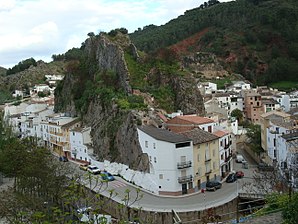Cambil
| Cambil municipality | ||
|---|---|---|
 Cambil - town view
|
||
| coat of arms | Map of Spain | |

|
|
|
| Basic data | ||
| Autonomous Community : |
|
|
| Province : | Jaén | |
| Comarca : | Sierra Magina | |
| Coordinates | 37 ° 41 ′ N , 3 ° 34 ′ W | |
| Height : | 770 msnm | |
| Area : | 139.89 km² | |
| Residents : | 2,703 (Jan 1, 2019) | |
| Population density : | 19.32 inhabitants / km² | |
| Postal code : | 23120 | |
| Municipality number ( INE ): | 23018 | |
| administration | ||
| Website : | Cambil | |
Cambil is a southern Spanish town and a municipality ( municipio ) consisting of the main town and the village of Arbuniel as well as several individual farms with a total of 2,703 inhabitants (as of January 1, 2019) in the south of the province of Jaén in the autonomous region of Andalusia . The old town center is recognized as the conjunto histórico-artístico .
location
The place Cambil is located in the Sierra Mágina , a sub-area of the Sierra Morena , almost 32 km (driving distance) southeast of the provincial capital Jaén at an altitude of about 760 to 780 m above sea level. d. The climate in winter is temperate, in summer it is warm to hot; the low amounts of precipitation (approx. 530 mm / year) fall - with the exception of the almost rainless summer months - distributed over the whole year.
Population development
| year | 1857 | 1900 | 1950 | 2000 | 2016 |
| Residents | 3.137 | 4,454 | 7,634 | 3,108 | 2,802 |
The continuous population decline in the second half of the 20th century is mainly due to the mechanization of agriculture and the associated loss of jobs.
economy
Cambil is located in the south of the seemingly endless olive tree plantations of the Jaén province. In the past, cereals, vines, etc. were also planted for self-sufficiency ; Vegetables came from the house gardens. Small traders, craftsmen and service companies of all kinds have settled in the village. There are also several holiday homes (casas rurales) .
history
Several Bronze Age rock graves were discovered during the construction of a tunnel in the municipality . Several sarcophagi and columns near the village of Arbuniel date from Roman times . At the beginning of the 8th century the area was overrun by the Moors ; they called the place Qanbil . After the end of the Caliphate of Cordoba (1031), the area became part of the Taifa Kingdom of Jaén. Around the middle of the 12th century, the place was incorporated into the newly formed Almohad Empire, which, after its defeat in the battle of Las Navas de Tolosa (1212) , faced increasing attacks by its Muslim ( Ibn Hud , Muhammad I ibn Nasr ) and Christian neighbors looked exposed. Cambil was recaptured by the Christians as early as 1315 ( reconquista ) , but could only be held as a border town to the Muslim kingdom of Granada for 50 years. Just a few years before the conquest of Granada, Cambil became Christian again. With the Alhambra Edict (1492) of the Catholic Kings began the expulsion of the Sephardic Jews ; in the years around 1610 the last Muslims ( moriscos ) were also expelled.
Attractions
- From the two medieval castles of the place (Castillo de Cambil, Castillo de Alhabar) only small traces can be seen.
- The local parish church (Iglesia Parroquial de Nuestra Señora de la Encarnación) was built in the 16th century over a previously demolished mosque . The multi-figure, but clearly structured altarpiece is a work by Sebastián de Solís from the early 17th century; However, it was only gilded and colored around 1670.
- Surroundings
- The Castillo de Mata Bejid , built by the Moors in the 12th or 13th century, is located approx. 12 km northeast of Cambil. It was conquered by the Christians in the 14th century. The keep (torre del homenaje) is still recognizable; There is a cistern (aljibe) in the courtyard .
Web links
Individual evidence
- ↑ Cifras oficiales de población resultantes de la revisión del Padrón municipal a 1 de enero . Population statistics from the Instituto Nacional de Estadística (population update).
- ↑ Cambil - Map with altitude information
- ↑ Cambil - climate tables
- ↑ Cambil - population development
- ↑ Cambil - Economy etc.
- ↑ Cambil History
- ↑ Cambil - History in Key Words
- ↑ Cambil Church

